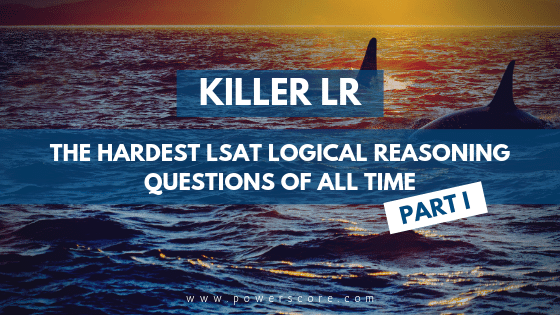
Below is Part I of our discussion of the 15 hardest LSAT Logical Reasoning questions of all time. This Part contains 5 of the 15 questions, which will be presented in chronological order. In Part II we discuss questions 6-10 on the list and in Part III we present questions 11-15. Part IV is our finale where we discuss some of the interesting patterns and statistics associated with the questions on the list. We chose this list by looking at statistics from students’ practice tests, the volume of questions we receive from students about a LR question, and our own experience teaching and writing about these questions.
Keep in mind that these questions present various types of difficulty. Some of the most difficult LSAT questions are so sly that you don’t even realize you’ve done a difficult question! You confidently move on and only realize later that you answered incorrectly. Other questions are clearly challenging from the start–you are aware it’s stumping you when choosing an answer. So, this list presents some obviously difficult questions and questions whose difficulty might have become more obvious only in retrospect.
October 1994, Section 1, #24: Vinland Map Titanium Ink
Flaw in the Reasoning. This question involves the presence of titanium in both the Gutenberg Bible and the B-36 Bible. Respondents answered this question correctly at a rate of just 15%. Guessing at random yields a 20% hit rate, meaning the correct answer was harder to find than taking a guess. Statistically speaking, this is the second hardest LSAT Logical Reasoning question ever to appear. Although, from a pure difficulty standpoint this may be the hardest.
December 1994, Section 1, #18: Grand Banks Cod
Must Be True. Must questions are not generally among the hardest Logical Reasoning questions, but the Grand Banks Cod question is one of the exceptions. The question contains a discussion of separate estimates of cod stocks, one of which has increased by the same amount that the other has decreased. The two estimates offset each other, leading the overall official estimate to stay the same. The very casual language in the correct answer makes this question even more challenging.
December 1995, Section 2, #23: Airline Seat Cancellation
Justify-PR. This was one of the first Justify-PR questions. In this argument, Arnold and Jamie argue about the moral obligation of an airline to compensate a traveler for a cancelled flight. Because of the Principle aspect in this question, the answers have a more abstract quality, and students answered it correctly at a rate of just 21%.
October 1996, Section 1, #16: Brown Dwarfs
Assumption-FL. There have been other questions about brown dwarfs on the LSAT before, but this was the first and by far the most difficult. The Formal Logic aspect by itself makes the question much harder for most students (most people probably think there’s a special level of hell reserved for the makers of Formal Logic questions). The addition of several science terms (brown dwarfs, red stars, hydrogen, lithium, helium) adds to its difficulty.
June 1997, Section 1, #19: Meteorite Impact Crater
AssumptionX. This is a tricky question, because the correct answer, which is not an Assumption of the argument, is incorrect because of the presence of one word: “more.” And, because the correct answer is (A), many students quickly bypassed (A) and then never returned to it, leaving them to choose an incorrect answer. The science element also adds to the difficulty of this problem.
* * *
One final note about this list. By definition, any such list such is somewhat subjective, and a question that is a challenge for one student may not be difficult for another. The questions listed above are ones that students regularly ask about, and the ones we know from statistics and our experience to be extremely difficult. If you can correctly solve any of the questions on the list in less than two minutes, you have done a great job.
Further Reading about the Killer LSAT: Killer RC, Killer LG, Killer LR Part I, Part II, Part III, Part IV


Leave a Reply